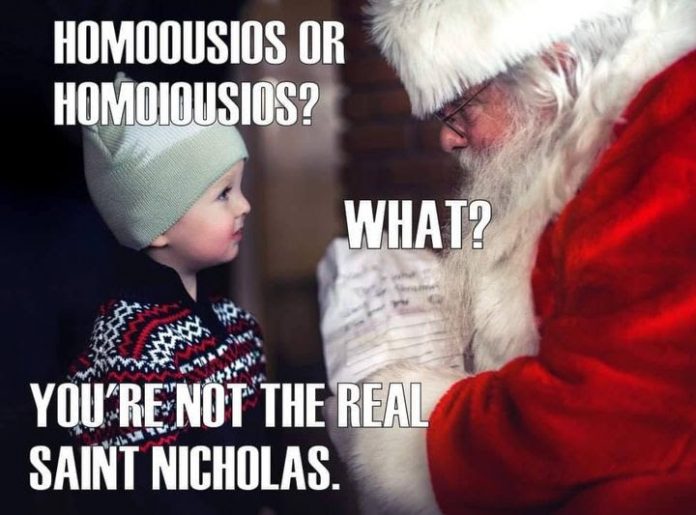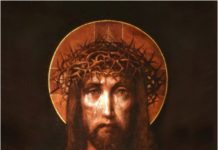Saint Nicholas of Myra (+343) has gone down in legend in more ways than one. His general story follows below, but through the years has developed into the genial ‘Santa Claus’, the rotund, cherubic figure, a creation of the cartoonist Thomas Nast in Harper’s Weekly in 1881, with the red suit and ample physiognomy, which was in turn developed for an advertising campaign of Coca-Cola. Charles Coloumbe has a very good history of Santa over at OnePeterFive.
We don’t know all that much about the real Saint Nicholas. Earlier in his life, he made a pilgrimage to the Holy Land, to learn from the desert fathers, monks like Saint Anthony of Egypt who left everything to follow Christ. Under the persecution of Diocletian, he was imprisoned, but released when Constantine legalized Christianity in 313. Recognized for his holiness and erudition, Nicholas was ordained bishop of Myra (now in Turkey), and soon renowned for his solicitude for the people of his diocese, especially the poor. As an aside, he is also called ‘Nicholas of Bari’, a coastal city in southeastern Italy, just above the heel of the country’s boot, due to the fact that his relics were taken there in 1087 – a decade before the first Crusade – to save them from the marauding, iconoclastic Turkish Muslims, who had a lamentable tendency of destroying every Christian shrine and relic they came across, as they still do, in Islam’s various permutations.
There are Nicholas’ legendary charitable works – whatever their historical origins – signifying a man of great soul, who has gone down in history, much more than the mythical red-nosed reindeer who guided his sled across the North Pole into the various antipodes.
The gift-giving has its origins in the story of Nicholas rescuing three young women, whose father had squandered their savings, leaving them in the tragic fate, in that rather brutal age, of being sold into prostitution. The good bishop, in the dark of night, dropped three successive bags of gold through an open window – safer than the proverbial chimney – enough for each of their dowries. Hence, his connection with gift-giving and the aforementioned morphing into ‘Santa Claus’. The gold coins apparently landed in their shoes – hence the custom of gifts in footwear and stockings. (See also this article in Crisis, and Luther’s own, perhaps unintended, influence on the legend).
There are any number of other stories: of Nicholas saving three innocent men from execution; of Nicholas resurrecting thee children who had been killed by a butcher during a famine, owho was going to sell them off disguised as ‘ham’ (and this rather macabre legend was one of the most popular in the Middle Ages, being depicted in all sorts of paintings and stained glass); of Nicholas saving the ship on which he was sailing to the Holy Land from certain destruction during a violent storm.
Hence, Saint Nicholas is one of the most popular saints in history, and the patron saint of any number of things: of children, the Dutch and of Holland – a nation once Catholic, now steeped in the culture of death, needing our prayers – sailors, coopers, archers and, one of my favourite, brew-masters.
Also, according to legend, he was one of the key figures at the first great Ecumenical Council of Nicaea in 325, called by the Emperor Constantine to decide the fate of, and questions raised by, the deacon Arius of Alexandria, who claimed that Christ was not really divine, but rather the greatest of God the Father’s creatures. There was a time when he was not, cried the Arians.
From contemporary accounts – Eusebius of Caesarea wrote a history – the Council was a fractious one, with later stories of Nicholas pulling the beard of, or perhaps slapping, Arius in frustration at his contumaciousness in his blasphemous heresy, and maybe to knock some orthodoxy into him.
The watchword proposed by Saint Athanasius and the papal legates was homo-ousios, or, in Latin, consubstantialis, that Christ was indeed the ‘same nature’ as the Father, that is, He was truly God, eternal, and eternally begotten before all ages.
Others, the semi-Arians (amongst whom was Eusebius himself) sought a compromise: Why don’t we all agree on adding just one iota – the smallest Greek letter – homoi-ousios, meaning that Christ is similar to the Father? Then we could all get along.
But truth is truth, and to say that Christ is ‘like’ God the Father would be tantamount to saying that Christ is ‘like’ any creature, which each in their own way is ‘like’ God, in their beauty and goodness. To say no more than that would have destroyed the Catholic Faith, which hinges upon the Incarnation.
It shall not be so, said the orthodox bishops at the Council, Athanasius and Nicholas amongst the foremost, defending the papal position that Christ is God, as held firmly in Scripture and Tradition. And by the grace of the same God, that is what the Council decided, promulgating the Creed that goes by its name, which we recite every Sunday and Solemnity, that Christ is God from God, Light from Light, true God from true God, begotten, not made, consubstantial (homo-ousios) with the Father.
For the sake of one iota, indeed.
And Christ – God the Word made flesh – will come again at the end of time in glory, to judge the living and the dead, when we will all find out who has been naughty and nice, and who sees us as we are sleeping or awake, and Who will reward those faithful to Him with gifts far beyond our expectations.
So ho-ho-homo-ousios, and a blessed feast of this great defender of the Faith to one and all!
Saint Nicholas, ora pro nobis! +












